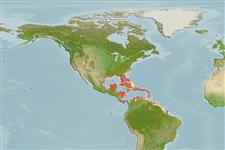>
Eupercaria/misc (Various families in series Eupercaria) >
Labridae (Wrasses)
Etymology: Lachnolaimus: Greek, lachne, -es = more covered with hair than other + Greek, laimos = throat (Ref. 45335).
More on author: Walbaum.
Environment: milieu / climate zone / depth range / distribution range
Ecologie
marien rifbewoner; diepte 3 - 30 m (Ref. 9710). Subtropical; 46°N - 4°N, 98°W - 51°W
Western Atlantic: Nova Scotia (Canada), Bermuda, and northern Gulf of Mexico to northern South America.
Lengte bij maturiteit / Grootte / Gewicht / Leeftijd
Maturity: Lm 18.1 range ? - ? cm
Max length : 91.0 cm TL mannelijk / geslacht onbekend; (Ref. 7251); common length : 35.0 cm TL mannelijk / geslacht onbekend; (Ref. 3726); max. gepubliceerd gewicht: 11.0 kg (Ref. 36052); max. gerapporteerde leeftijd: 23 Jaren (Ref. 93706)
Dorsale stekels (totaal) : 14; Dorsale zachte stralen (totaal) : 11; Anale stekels: 3; Anale zachte stralen: 10. Deep-bodied wrasse with a strongly arched dorsal profile. First 3 dorsal spines filamentous. Only wrasse with elongate dorsal spines and such a highly arched profile (Ref. 26938). Color variable but generally mottled brownish red with a black spot at rear base of dorsal fin (Ref. 13442).
A large and economically valuable species, monandric and a protogynous hermaphrodite (Ref. 93709). Adults are found over open bottoms or coral reef areas (Ref. 5217). Often encountered where gorgonians are abundant (Ref. 13442). Feed mainly on mollusks, also crabs and sea urchins (Ref. 3726). Flesh highly esteemed; marketed fresh and frozen (Ref. 3726). Have been reared in captivity (Ref. 35420).
Monandric (no primary males) , protogynous hermaphrodites. Sex change is postmaturation; it is initiated among individuals 30-40 cm LF (or 3-5 yrs) but was also observed in fish as large as 69.4 cm LF (13 yrs). Sex change occurred after one more spawning (as a female) seasons and requires several months to complete (Ref.74380). Harem spawner (Ref.74381). Spawning activity is characterised by the following event called 'spawning rush': 1) pectoral swim up, 2) tail swim, 3) swin alongsode and tilt, 4) release, 5) circle and display, and 6) swim down (Ref. 74381).
Robins, C.R. and G.C. Ray, 1986. A field guide to Atlantic coast fishes of North America. Houghton Mifflin Company, Boston, U.S.A. 354 p. (Ref. 7251)
Status op de Rode Lijst van het IUCN (Ref. 130435)
Gevaar voor de mens
Reports of ciguatera poisoning (Ref. 7251)
Gebruik door de mens
Visserij: van minder commercieel belang; sportvis: ja; Aquarium: Commercieel
Tools
Speciale rapporten
Download XML
Internetbronnen
Estimates based on models
Preferred temperature (Ref.
123201): 23.7 - 28.2, mean 27.2 °C (based on 697 cells).
Fylogenetische diversiteitsindex (Ref.
82804): PD
50 = 1.0000 [Uniqueness, from 0.5 = low to 2.0 = high].
Bayesian length-weight: a=0.02239 (0.01381 - 0.03628), b=2.95 (2.80 - 3.10), in cm total length, based on LWR estimates for this species & (Sub)family-body (Ref.
93245).
Trofisch niveau (Ref.
69278): 4.2 ±0.0 se; based on diet studies.
Weerstandsvermogen (Ref.
120179): Gemiddeld, minimale populatieverdubbelingstijd 1,4-4,4 jaar (K=0.09; Fec=100,000; tm=1.1).
Prior r = 0.19, 95% CL = 0.13 - 0.29, Based on 2 full stock assessments.
Fishing Vulnerability (Ref.
59153): High vulnerability (59 of 100).
Nutrients (Ref.
124155): Calcium = 15.1 [6.5, 32.9] mg/100g; Iron = 0.409 [0.207, 0.871] mg/100g; Protein = 19.2 [16.3, 21.6] %; Omega3 = 0.139 [0.072, 0.268] g/100g; Selenium = 16.8 [6.0, 39.7] μg/100g; VitaminA = 33.2 [7.5, 187.3] μg/100g; Zinc = 0.578 [0.359, 0.973] mg/100g (wet weight);
